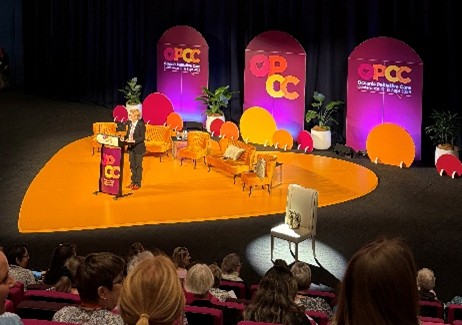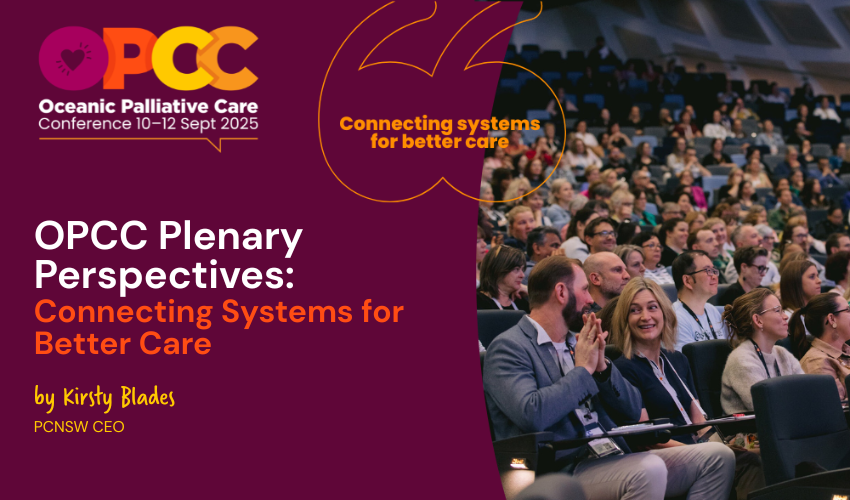
The first plenary session of OPCC featured three keynote speakers presenting their stories, programs and plans. There was a clear focus on truly considering what person-centred care is, heightened by the clever addition on the stage of a single unoccupied chair that was spotlit to represent the individual with a life-limiting illness. That chair served as a constant reminder that whatever we discuss, consider, implement or do must always have that person front, centre and spotlighted.
Professor Brian Dolan OBE (UK) kicked off the session asking us to deeply consider every individuals experience and framed it by asking us to think about the last 1000 days of a person’s life, also the name of the global social movement he founded #Last1000Days, to value patients’ time. You never know when your last 1000 days will start. But when it does start, would you want to spend it stuck in a hospital bed, at endless appointments retelling your medical story multiple times, or would you prefer to spend your valuable time with the people you love? How as healthcare professionals do we also value that time? What is the impact on the patient and their families when people get stuck in hospitals, systems and silos that take days away from that person, when they do not have time to waste? What is that social impact when precious days are lost? Brian implored all of us to think about the changes we can make that values a patients time, to make a stand, and influence change.
Watch the last 1000 days video here
Dr Jun Sasaki (Japan), CEO & Chairman, Yushoukai Medical Corporation then shared a fascinating journey of how Japan is transforming palliative care for an aging society, with Japan already becoming a “Super Aged Society”. Yushoukai is the largest group of home care clinics in Japan with 24 clinics, 170 doctors and 9,000 home care patients. Dr Sasaki’s presentation abstract highlights the challenges that Yushoukai is tackling:
Japan’s rapidly aging population presents three major challenges. First, the number of older adults requiring long-term care is increasing, as age-related physical and cognitive decline becomes more prevalent. Second, the incidence of chronic diseases such as cancer, heart failure, and respiratory failure continues to rise with longevity. Third, the limits of the traditional medical model are evident: specialist care and hospital-centered services alone cannot adequately improve patients’ outcomes or quality of life.
Our current health system, built around acute hospital care, is not fully equipped to meet these changing social and medical needs. A shift toward robust home-based medical and palliative care is essential. This includes ongoing, holistic preventive support and the capacity to provide 24-hour emergency response at home, ensuring that patients can remain safely and confidently in their own environment until life’s end.
Home-based palliative care is a vital tool for enabling a good life and a dignified death. For it to function effectively, both the structure of healthcare delivery and the mindset of healthcare professionals must evolve—embracing community-based, patient-centered, and integrated approaches that extend beyond traditional medical boundaries.
The following insights and stats really stuck with me, highlighting the need, but also the success of this home-based program:
- Social change is leading to an increase in hospitalisations. The traditional image of a Japanese household consisting of parents with 2 children in the 70’s, 80’s and 90’s has significantly shifted. Now 30% of households in Japan are solely made up of elderly people, with 17% of those being an elderly person living alone and 13% an elderly couple. The healthcare system in Japan had to respond, with many of these households having a limited support network. We know that this social change in households is also being experienced here in Australia.
- Through their research they discovered that the majority of hospitalisations were for mild to moderate symptoms or illnesses, which further highlighted that home-based care could address this need.
- Research also highlighted hospitalisation-associated disabilities showing that 10 days in the hospital equalled 7 years of ageing, which is a staggering finding. Now refer back to Professor Dolans last 1,000 days. These findings from Japan demonstrate that any extended time in hospital is going to greatly impact those last 1,000 days.
- The Yushoukai Medical Corporation and their home-based care model has reduced the total number of inpatient days per person per year from 41.2 days to 11.5 days.
- There has been a reduction in hospitalisation by 300,000 days in total, saving the Japanese healthcare system $100M. The equivalent value in AUD, based on the average cost of a hospital bed of $1,075 per day (according to NSW Health) would be $322M.
This program highlights the value and impact that home-based care can have on individuals, communities and healthcare systems. It also highlights how important it is to have robust research that confirms the challenges or issues, identifies the reasons and then measures impact. How do we know what we are really trying to solve and if we are being successful without this type of evidence and research?
As a side note, I do love how the Yushoukai Medical Corporation describes themselves: A “human group to make people happy”.
We then heard from Professor Dorothy Keefe (Aust), CEO, Cancer Australia, Australia’s national cancer agency. Professor Keefe is an advocate for palliative care being an essential component of high-quality cancer care. It was highlighted though, that access to palliative care remains inequitable across Australia, particularly for those in rural and remote areas, Aboriginal and Torres Strait Islander peoples, and children and young people with cancer.
Professor Keefe’s abstract outlined that ‘embedding palliative care into every relevant stage of the cancer care continuum and strengthening collaboration across systems is critical to ensure that all Australians have early access to care that is coordinated, compassionate, and culturally safe’. An Optimal Care Pathway was presented highlighting palliative care and the cancer ecosystem, with Palliative Care starting at the diagnosis of an incurable disease but with a note on consideration of need, as opposed to prognosis. End-of-Life care is the last of the seven steps of the cancer continuum as set out in the Optimal Care Pathways.
Through the Rare Cancers Australia (RCA) Cancer Lived Experience Survey, gaps in palliative care were identified. RCA ran this inaugural national survey, with nearly 2,500 responses from people diagnosed with cancer and their carers, with the findings released on the 1st of September this year. Access the report here. The findings highlighted that 1 in 2 reported poorly coordinated care, with supportive care navigators considered a key unmet need for both patients and carers. Carers were highlighted as being under supported, particularly at end-of-life with around 30% saying their loved one didn’t receive adequate end-of-life care, and many carers felt unsupported during that critical period. These findings further highlight the need for strengthened collaboration and coordinated care pathways.
Professor Keefe has been instrumental in the development of the first national Australian Cancer Plan and she highlighted that of the six strategic objectives, each with 2 and 5 year goals, there were 27 goals that contribute to improvements in palliative care. The plan prioritises the development and refinement of integrated care models, which should in turn maximise access to high-quality, timely and evidence-based palliative and end-of-life care, including voluntary assisted dying.
Resources and networks of interest include:
- Optimal Care Pathways Interactive Web App
- Optimal care pathway for Aboriginal and Torres Strait Islander people with cancer.
- Consider joining the Australian Comprehensive Cancer Network (ACCN). Through the ACCN, health services and individuals have the opportunity to connect with Comprehensive Cancer Centres and other centres of excellence that can provide specialist knowledge, clinical expertise, and capability. ACCN members are given access to a members-only portal to connect, collaborate, and share knowledge with other members of the Network. Professor Keefe did share that a palliative care discussion forum is coming as part of the ACCN.
The session concluded with a discussion that largely focussed on access to palliative care and timely referral. Some of the key points made were:
- That referral at time of diagnosis of an incurable disease would likely overwhelm the system, with more funding needed for palliative care if that was to be achieved. It is therefore increasingly important to consider need vs prognosis in the referral process.
- With a person-centred lens, the right time for a referral should be when an individual is ready, noting though that the individual will need easy access to the right information to be able to make that call.
- That we might all think that at time of referral people want a Rolls Royce but they might only need a Toyota (no offence to Toyota owners, I am one of them), or they only need a part of the Rolls Royce. How are we determining that at time of referral or are we just assessing all referrals thinking they want the Rolls Royce and declining referrals as the Rolls Royce support is not currently available?
- There is strong evidence for early referral, but supporting systems and implementation processes are missing.
- A lack of public health palliative care approaches and a reiteration of the message: dying being a social event with medical component, not a medical event with a social component. A question was further posed on how are we improving health promotion and death literacy in the community.
As the session wrapped up, the speakers shared their collective hopes including recognition that palliative care is not just about the profession or a service definition, but is something every community should have equitable access to, hope that there is a continued awakening and reinforcement to the person being the centre of care, and hope in the continued belief that this is something working for and fighting for. We can all get on board with that!
Written by Kirsty Blades, CEO, Palliative Care NSW


